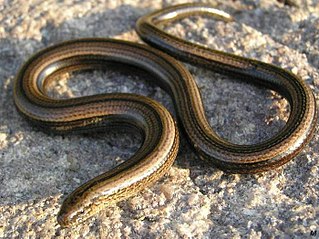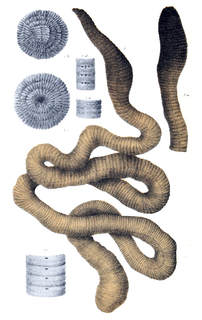Related Research Articles

Compost is organic matter that has been decomposed in a process called composting. This process recycles various organic materials otherwise regarded as waste products and produces a soil conditioner.
Leaf mold is the product of slow decomposition of deciduous shrub and tree leaves. It is a form of compost produced primarily by fungal breakdown.

Vermicompost is the product of the decomposition process using various species of worms, usually red wigglers, white worms, and other earthworms, to create a mixture of decomposing vegetable or food waste, bedding materials, and vermicast.

Lumbricus terrestris is a large, reddish worm species widely distributed around the world. In some areas where it is an introduced species, some people consider it a serious pest for outcompeting native worms. It has an unusual habit of copulating on the surface at night, which makes it more visible than most other earthworms.

Slowworms are a small genus (Anguis) of snake-like legless lizards in the family Anguidae. The genus has two living species, the common slowworm and the Peloponnese slowworm and up to three fossil species.

Oligochaeta is a subclass of animals in the phylum Annelida, which is made up of many types of aquatic and terrestrial worms, including all of the various earthworms. Specifically, oligochaetes comprise the terrestrial megadrile earthworms, and freshwater or semiterrestrial microdrile forms, including the tubificids, pot worms and ice worms (Enchytraeidae), blackworms (Lumbriculidae) and several interstitial marine worms.

A composting toilet is a type of dry toilet that treats human excreta by a biological process called composting. This process leads to the decomposition of organic matter and turns human excreta into compost-like material but does not destroy all pathogens. Composting is carried out by microorganisms under controlled aerobic conditions. Most composting toilets use no water for flushing and are therefore called "dry toilets".

The giant Gippsland earthworm, Megascolides australis, is one of Australia's 1,000 native earthworm species. It is also commonly known as karmai, taken from the Bunwurrung language.

Eisenia fetida, known under various common names such as redworm, brandling worm, panfish worm, trout worm, tiger worm, red wiggler worm, etc., is a species of earthworm adapted to decaying organic material. These worms thrive in rotting vegetation, compost, and manure. They are epigean, rarely found in soil. In this trait, they resemble Lumbricus rubellus.

The giant Palouse earthworm or Washington giant earthworm is a species of earthworm belonging to the genus Driloleirus inhabiting the Palouse region of Eastern Washington and North Idaho, in the United States. The worm was discovered in 1897 by Frank Smith near Pullman, Washington. It can burrow to a depth of 15 feet (4.6 m).
Worm charming, worm grunting, and worm fiddling are methods of attracting earthworms from the ground. The activity is usually performed to collect bait for fishing but can also take the form of a competitive sport in areas such as east Texas. As a skill and profession worm charming is now very rare, with the art being passed through generations to ensure that it survives.
The Oregon giant earthworm is one of the largest earthworms found in North America, growing to more than three feet in length. First described in 1937, the species is not common. Since its discovery, specimens have been documented in only fifteen locations within Oregon's Willamette Valley.

Fishing bait is any substance used to attract and catch fish, e.g. on the end of a fishing hook, or inside a fish trap. Traditionally, nightcrawlers, insects, worms and smaller bait fish have been used for this purpose. Fishermen have also begun using plastic bait and more recently, electronic lures to attract fish.

Worms are many different distantly related animals that typically have a long cylindrical tube-like body, no limbs, and no eyes. Worms vary in size from microscopic to over 1 metre (3.3 ft) in length for marine polychaete worms, 6.7 metres (22 ft) for the African giant earthworm, Microchaetus rappi, and 58 metres (190 ft) for the marine nemertean worm, Lineus longissimus. Various types of worm occupy a small variety of parasitic niches, living inside the bodies of other animals. Free-living worm species do not live on land, but instead, live in marine or freshwater environments, or underground by burrowing. In biology, "worm" refers to an obsolete taxon, vermes, used by Carolus Linnaeus and Jean-Baptiste Lamarck for all non-arthropod invertebrate animals, now seen to be paraphyletic. The name stems from the Old English word wyrm. Most animals called "worms" are invertebrates, but the term is also used for the amphibian caecilians and the slowworm Anguis, a legless burrowing lizard. Invertebrate animals commonly called "worms" include annelids, nematodes (roundworms), platyhelminthes (flatworms), marine nemertean worms, marine Chaetognatha, priapulid worms, and insect larvae such as grubs and maggots.

An earthworm is a tubular, segmented worm of the phylum Annelida. They occur worldwide and are commonly found in soil, eating live and dead organic matter. An earthworm's digestive system runs the length of its body. It respires through its skin. It has a double transport system made of coelomic fluid that moves within the fluid-filled coelom and a simple, closed circulatory system. It has a central and a peripheral nervous system. Its central nervous system consists of two ganglia above the mouth, one on either side, connected to a nerve running along its length to motor neurons and sensory cells in each segment. Large numbers of chemoreceptors concentrate near its mouth. Circumferential and longitudinal muscles edging each segment let the worm move. Similar sets of muscles line the gut, and their actions move digesting food toward the worm's anus.

The European nightcrawler is a medium-small earthworm averaging about 1.5 g when fully grown. Generally blueish, pink-grey in color with a banded or striped appearance, the tips of their tails are often cream or pale yellow. When the species has not been feeding, it is pale pink. The species is usually found in deep woodland litter and garden soils that are rich in organic matter in European countries. E. hortensis is sold primarily as a bait worm, but its popularity as a composting worm is increasing.

Invasive species of earthworms from the suborder Lumbricina have been expanding their range in North America. Their introduction can have marked effects on the nutrient cycles in temperate forests. These earthworms increase the cycling and leaching of nutrients by breaking up decaying organic matter and spreading it into the soil. Since plants native to these northern forests are evolutionarily adapted to the presence of thick layers of decaying organic matter, the introduction of worms can lead to loss of biodiversity as young plants face less nutrient-rich conditions. Some species of trees and other plants may be incapable of surviving such changes in available nutrients. This change in the plant diversity in turn affects other organisms and often leads to increased invasions of other exotic species as well as overall forest decline.

Dendrodrilus rubidus is a species of earthworm in the family Lumbricidae. It is native to Europe, and it is a widespread introduced species, occurring on every continent except Antarctica, as well as many islands. It is often invasive. It is sometimes used as fishing bait, and is marketed under many nonspecific names, including red wiggler, jumping red wiggler, red trout worm, jumbo red worm, and pink worm. Other common names include bank worm, tree worm, and gilt tail.

A vermifilter is an aerobic treatment system, consisting of a biological reactor containing media that filters organic material from wastewater. The media also provides a habitat for aerobic bacteria and composting earthworms that produce humus. The "trickling action" of the wastewater through the media dissolves oxygen into the wastewater. This is an important feature because bacteria and worms that rapidly decompose organic substances need oxygen to survive. Wastewater is purified by removing pathogens and oxygen demand.
Amynthas mekongianus, the Mekong worm or Mekong giant earthworm, previously known as Megascolex mekongianus, is a species of earthworm in the family Megascolecidae. It is native to the vicinity of the River Mekong in southeastern Asia and may have more than 500 segments and grow to a length of 2.9 m (10 ft).
References
| This annelid-related article is a stub. You can help Wikipedia by expanding it. |